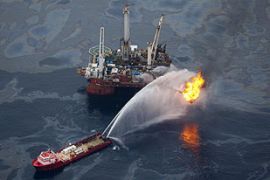BP forced to remove oil well cap
Energy firm removes containment device after underwater collision in Gulf of Mexico.

Currently, there is no containment system over the oil spill.
Unchecked oil
Admiral Thad Allen, of the US Coast Guard, said a remote-controlled submersible operating a mile beneath the surface had most probably hit a vent and compromised the system.
Live video from the seafloor showed oil and gas flowing out of the well unrestricted.
This was yet another complication in BP’s two-month-old struggle to contain the tens of thousands of barrels of oil spewing into the gulf.
| in depth | |
|
The system could restart later on Wednesday, he said.
Meanwhile, oil was pouring out unchecked from the opening that the cap covered, Allen said.
A second oil-capture system was operating normally, pulling more than 10,000 barrels a day to the surface and burning it off.
A team of US scientists estimates the leak is spewing up to 60,000 barrels a day.
Allen also reported two deaths of workers helping with the oil spill response. The deaths did not appear work-related but were under investigation, he said.
He said BP shut down the system when workers thought “some kind of gas” rose through a line that channels warm water to the cap to maintain temperature control.
The company said in a statement that a valve in that line spewed a liquid on the drill ship, Transocean Ltd’s Discoverer Enterprise.
Underwater collision
Allen said the robot apparently hit the top of the cap, closing one of three open vents through which oil and gas had continued to leak.
That could have created pressure that caused the problem with the water line, he said.
BP removed the cap to assess its condition. “They are checking the containment cap right now,” Allen said.
|
Al Jazeera looks at what caused the oil slick |
The company intends to reinstall the cap on a pipe remnant that juts from the top of failed blow-out preventer equipment at the seabed, he said.
Hours before Allen disclosed the cap removal, BP said both the oil-capture systems collected or burned off 27,100 barrels of oil on Tuesday, the highest capture rate yet.
The containment cap system installed on June 3 captured 16,600 barrels, while a second system started up on June 16 burned off 10,500 barrels, David Nicholas, the BP spokesman, said.
Tuesday’s overall capture rate was 900 barrels away from the total oil-handling capacity of 28,000 barrels, according to BP figures.
The combined systems have collected a total of 325,700 barrels of oil, BP said.
While the cap system channelled oil to the Discoverer Enterprise through a pipe, the second system was pulling more oil through a hose and pipe connected to the blow-out preventer.
Allen said that “potentially next Tuesday” another rig, the Helix Producer, will join the set-up to increase oil-handling capacity to up to 53,000 barrels a day.
“That’s notwithstanding the removal of the containment cap today,” he said.
Ban ‘blocked’
The setback comes amid the US interior department decision to reissue a ban on deep-water oil drilling that was blocked by a judgeon Tuesday.
The ban was put in place while a government committee investigated BP’s oil spill.
But companies who stood to lose business fought to overturn the decision.
Al Jazeera’s John Terrett, reporting from New Orleans, Louisiana, said the decision was “extraordinary”.
“An extraordinary situation in which a New Orleans-based district judge effectively issuing an injunction against the wishes of Barack Obama, the US president,” he said.
“On the other hand, Ken Salazar, the US interior secretary, has made it clear today that he intends to draw up another moratorium.
“Meanwhile the oil services companies, who yesterday were given the green light to go ahead, are not put into sea because they face another moratorium being imposed on them within days.”
